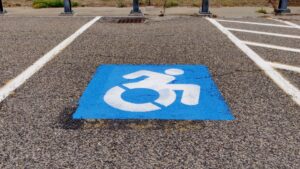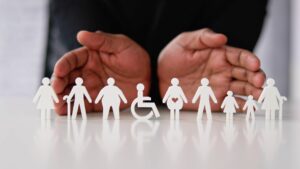A UK initiative to raise awareness of invisible disabilities
The United Kingdom has shown innovation in raising awareness about invisible disabilities. In 2019, a major initiative was launched: the creation of a specific logo for people with invisible disabilities, such as chronic illnesses or neurodevelopmental disorders, to facilitate their access to reserved parking spaces.
The goal is simple yet impactful: to enable those affected to use these spaces without facing judgment or criticism. This logo, often incorporated into parking badges, promotes clear and compassionate communication. As an advocate for this initiative stated: “Disability isn’t always visible, but respect should be.”

How does this logo work in the UK ?
This logo has been integrated into the Blue Badge scheme (the UK equivalent of the European parking card). Eligible individuals with non-visible disabilities can now apply for a badge featuring this symbol. It serves to indicate that their needs are legitimate, even if their disability isn’t immediately apparent.
For instance, someone with fibromyalgia or multiple sclerosis can use this logo to park closer to their workplace or daily activities. Jane, a teacher in London living with lupus, shared her experience: “Before, I used to dread the disapproving looks when I parked in these spaces. Now that I have this logo, I finally feel understood and respected.”
Criticisms and benefits : a better understanding of disability
While praised by many organizations, this initiative has also faced criticism. Some argue that the logo could be misunderstood or misused. However, the benefits far outweigh these concerns.
One of the key advantages is the increased awareness of invisible disabilities. By displaying this logo, individuals send a clear message: “My need is real, even if you can’t see it.” This visibility helps dismantle stereotypes and fosters greater empathy.
David, a transport manager at a local authority in the UK, explained: “Since introducing this logo, we’ve seen a reduction in disputes over parking spaces. People have a better understanding of the realities of invisible disabilities.”

Why France could learn from this practice
France could learn valuable lessons from this initiative. Individuals with invisible disabilities face similar challenges there: suspicion, misunderstanding, and insensitive comments. Adopting a similar logo would not only ease their daily lives but also promote a culture of inclusion and respect.
Take corporate parking lots, for example. By integrating such a logo into reserved spaces, employers would send a powerful message to their teams: every need matters, whether visible or not.
Invisible disability: using innovation to raise awareness
This British initiative highlights the importance of innovation in raising awareness about disabilities. Simple ideas, such as a logo, can have a profound impact on public perceptions.
Inclusion begins with concrete actions, no matter how small. Every symbol, every message counts in creating a more respectful world.
By adopting similar practices, France could not only improve the daily lives of those affected but also take a significant step toward building a more inclusive society. Invisible disabilities should no longer be a barrier, and innovation may be the key to changing perceptions.
